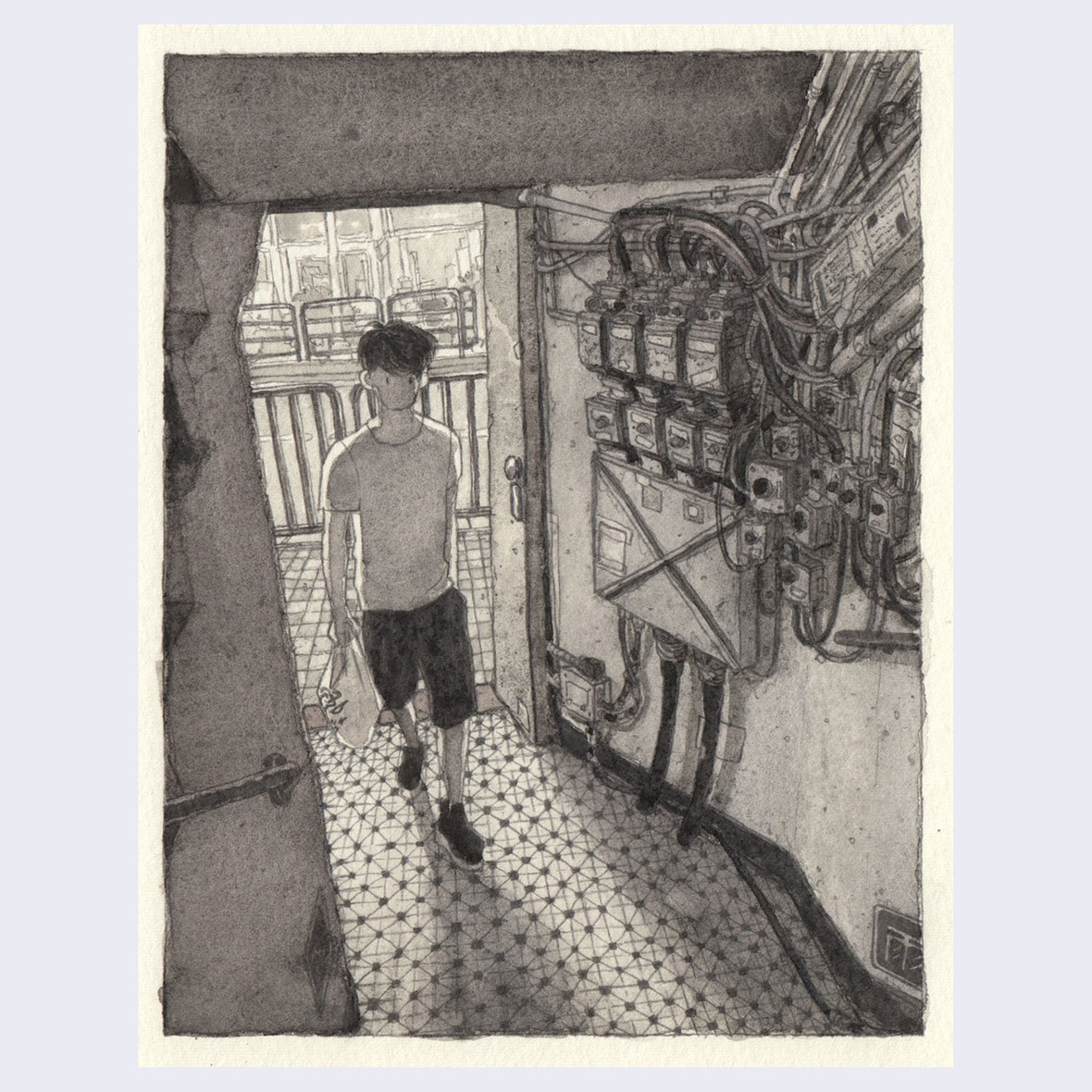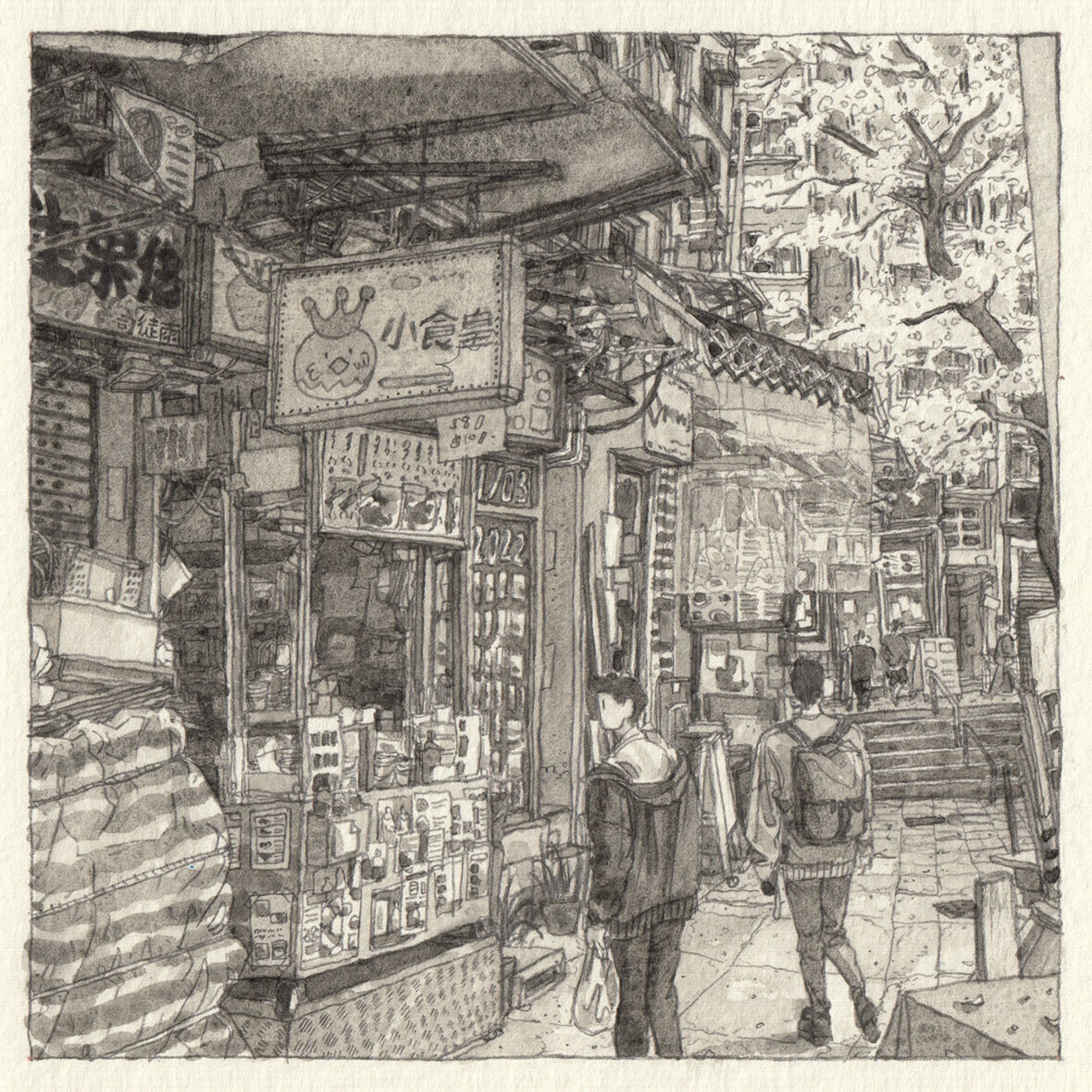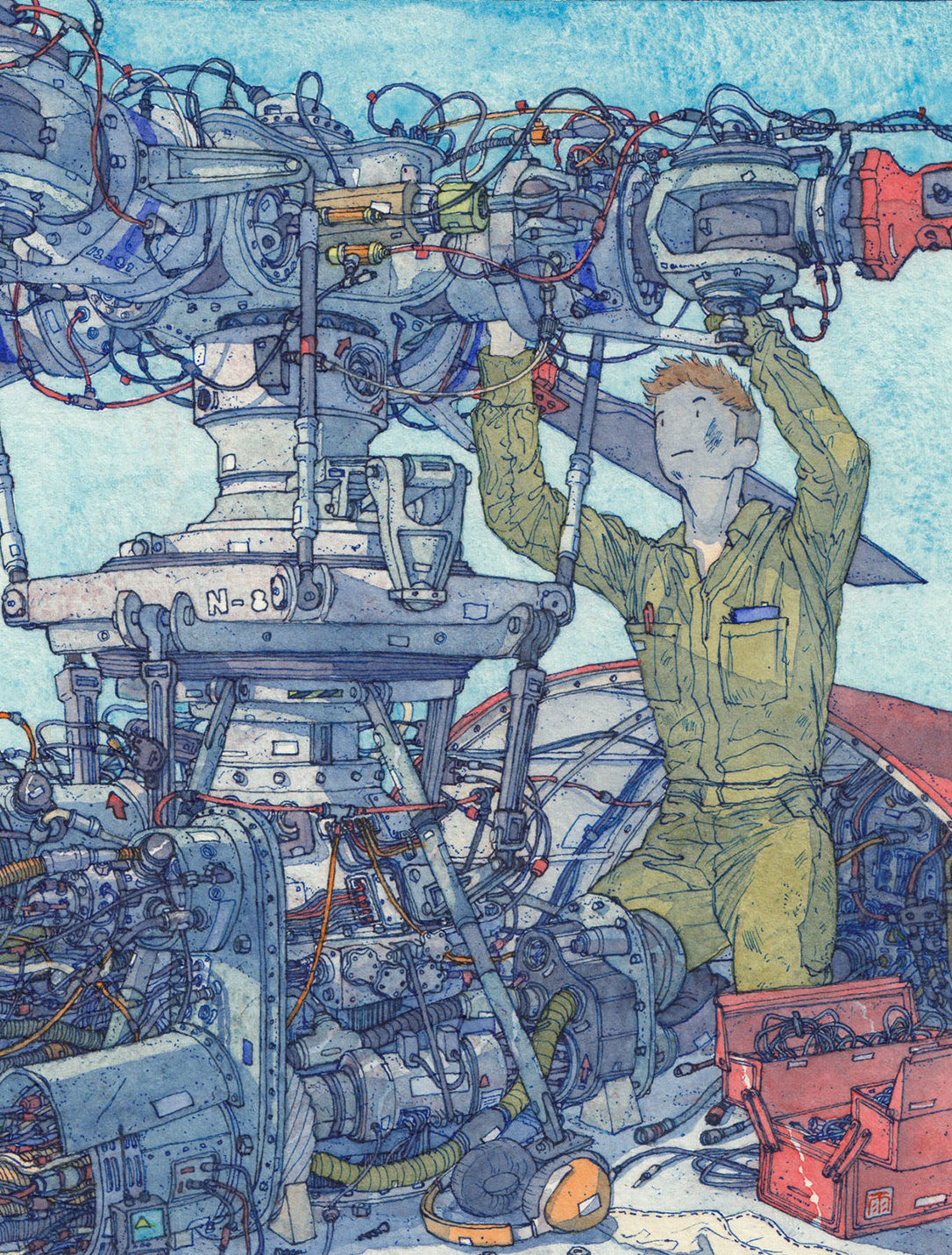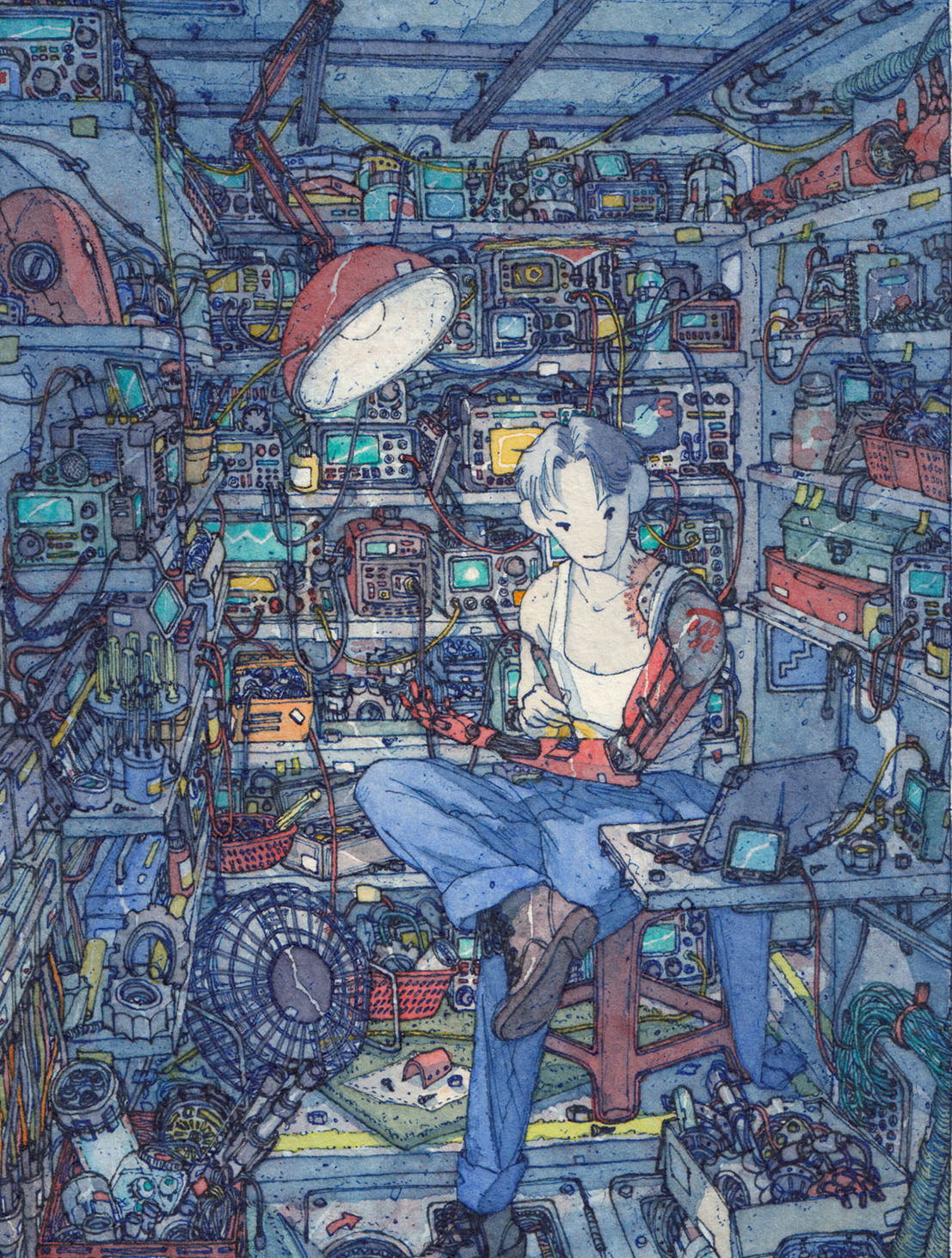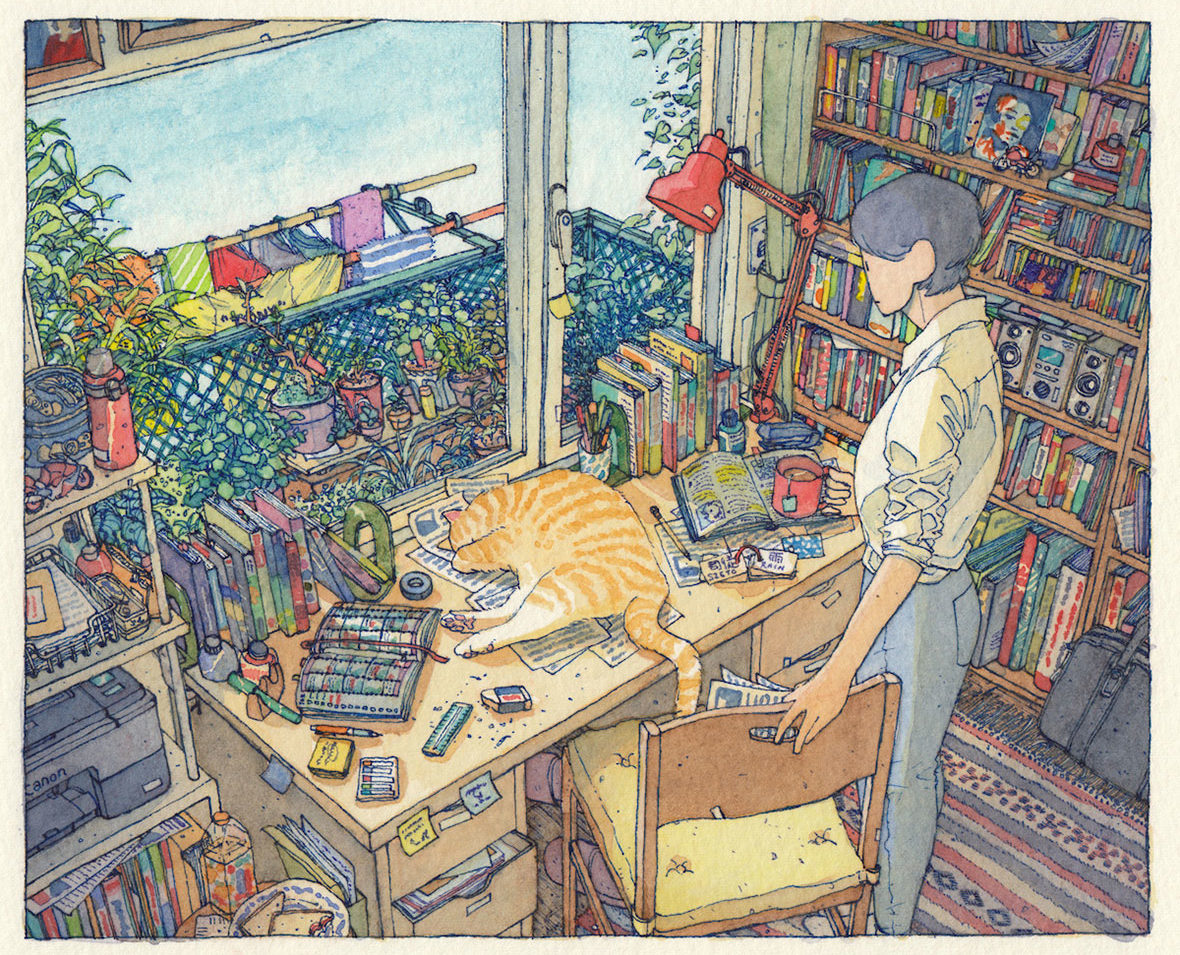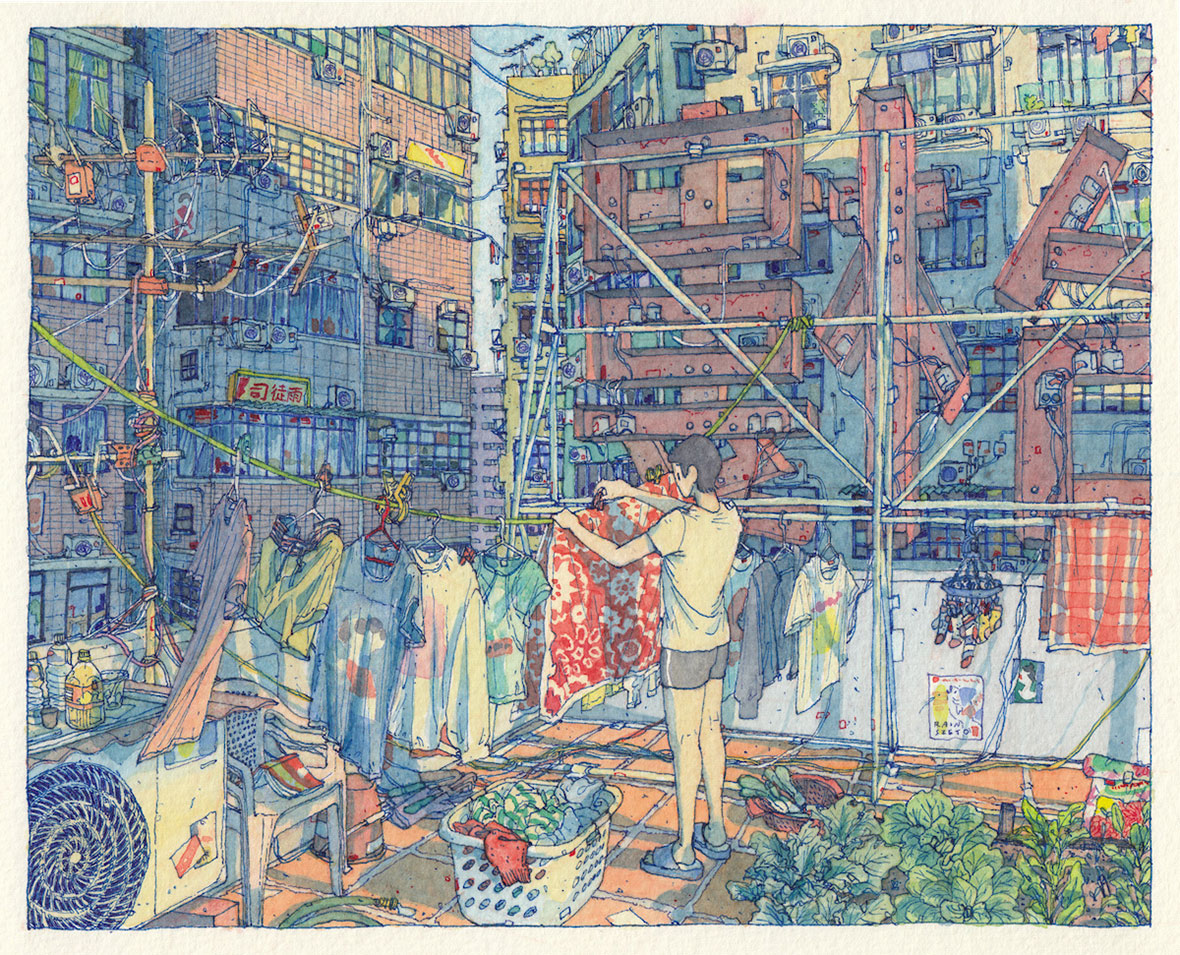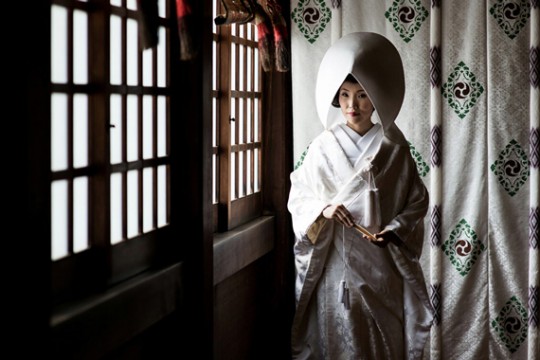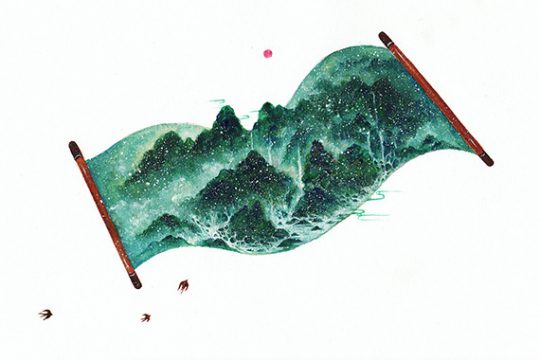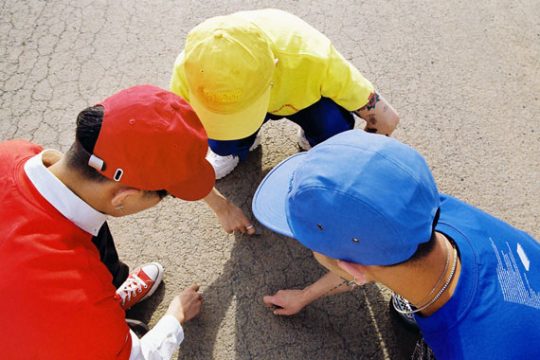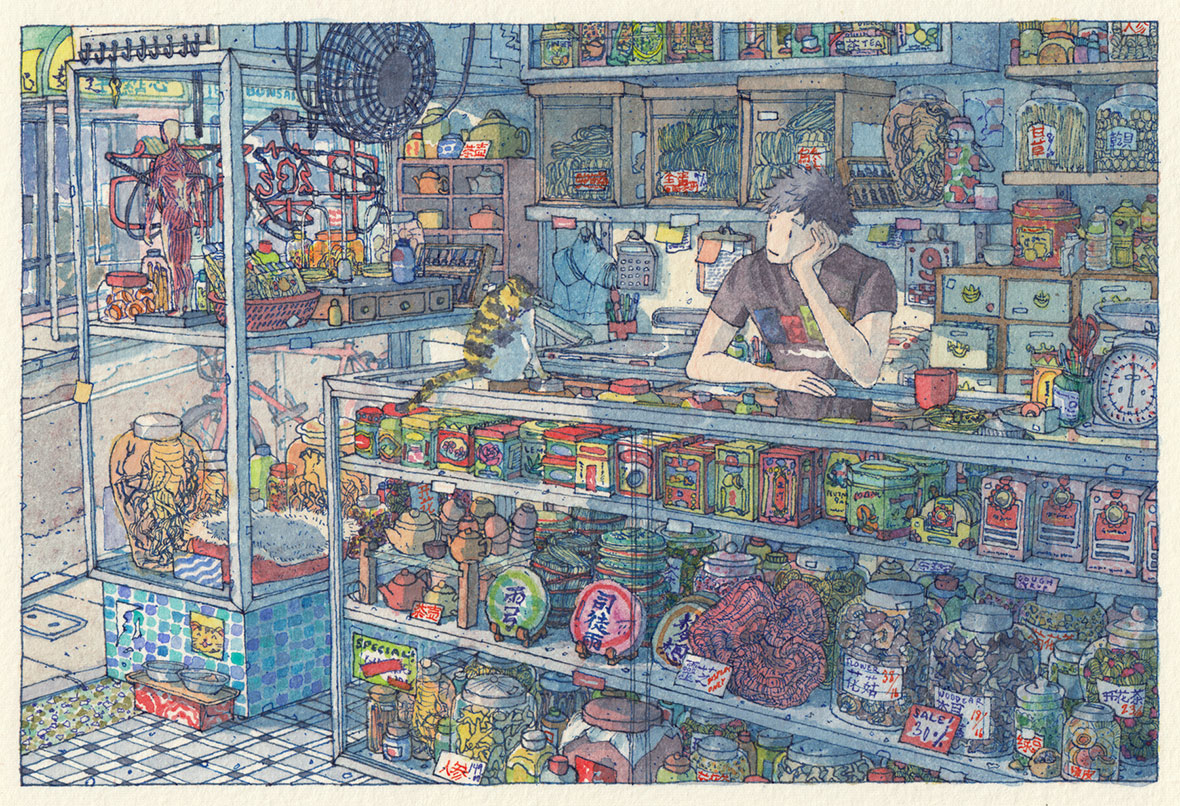
Rain Szeto paints watercolor illustrations of street life and science-fiction, all packed with an endless amount of detail that a viewer can lose themselves within. A picture depicting a cat laying blissfully in a ray of sunlight is crammed with as many objects as that of a cyborg repairman tinkering away in his studio. In her street scenes, shops are overbrimming with items; buildings are covered with signage, grime, and textures; and sidewalks are stuffed with foliage and vending machines. In her sci-fi work, wires feel tangled throughout the scene, bolts and dials are squeezed into every corner, and gadgets litter every available surface.
Rain Szeto 的水彩插画以一种爆炸式的科幻视角描绘我们日常里的街头场景,每幅作品都毫无例外地融入大量细节,令观众目不暇接。无论是阳光下惬意的猫,还是在工作室里捣鼓设备的机器人,所有场景都被各式各样的物品塞得满满当当。在她的作品中,小卖部里好像没有落脚的余地、街面上挤满了各类招牌,就连墙壁上的污垢和纹理都显而易见。各种电线在整个画面中蔓延纠缠,螺栓、仪表盘以及小工具散落在角落,这些都是增添科幻感的关键所在。
Whether it’s a cyberpunk-inspired scene or a simple restaurant, there’s always a certain mundanity to it—and it’s all by design. “I always try capturing the feeling of having something small to enjoy, or of being content in the moment,” Szeto says. “For sci-fi, the challenge lies in designing these futuristic elements so that they are not too far removed from our reality, while still clearly being sci-fi. For real world scenes, the challenge is arranging the scene in a way that feels lived-in and recognizable.”
从乍看之下的赛博朋克到细看下的人间冷暖,她的作品总透露出一抹平淡与凡俗。这恰恰是她想通过作品来传达的感觉,“我想要寻求一种小确幸式的心理,一种满足于当下平静状态,” Rain 说,“对于科幻题材的作品,则是想要挑战如何将未来主义元素变得更贴合现实,同时又能保留其科幻感;而那些生活场景的创作,则建立在生活中熟悉、平易近人的基准上。”
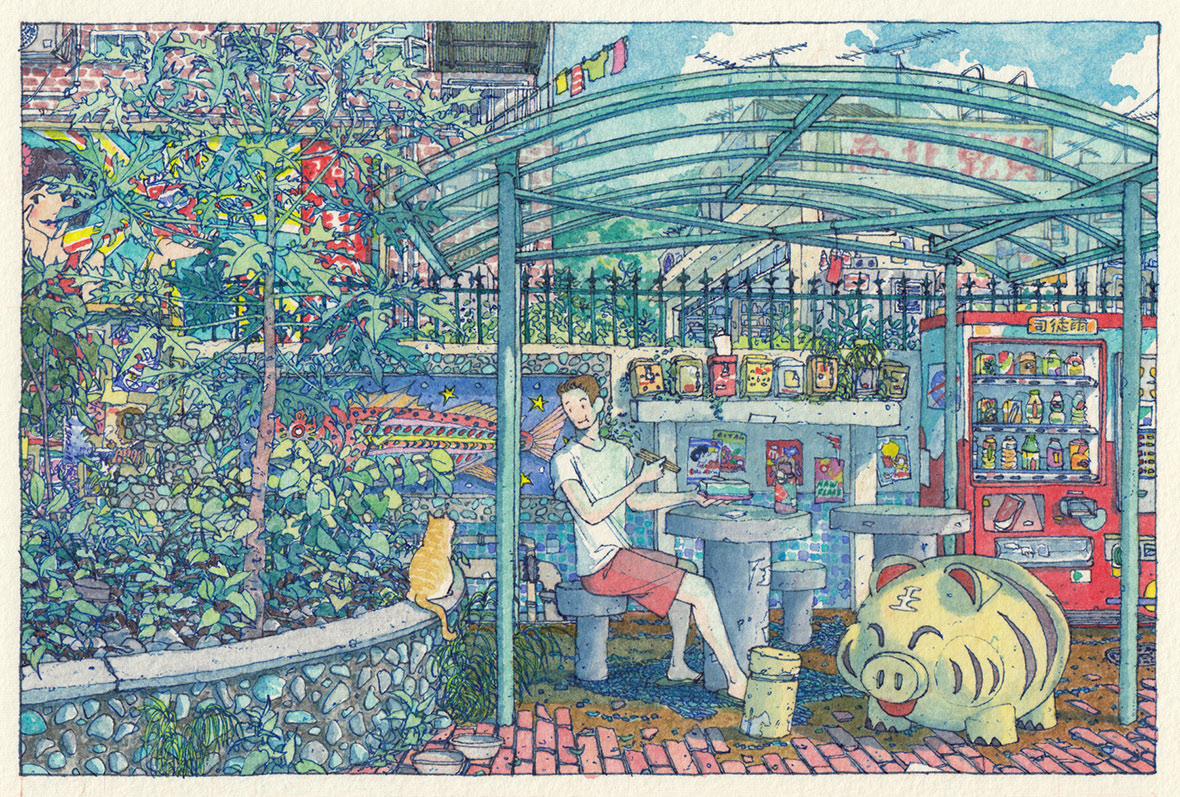
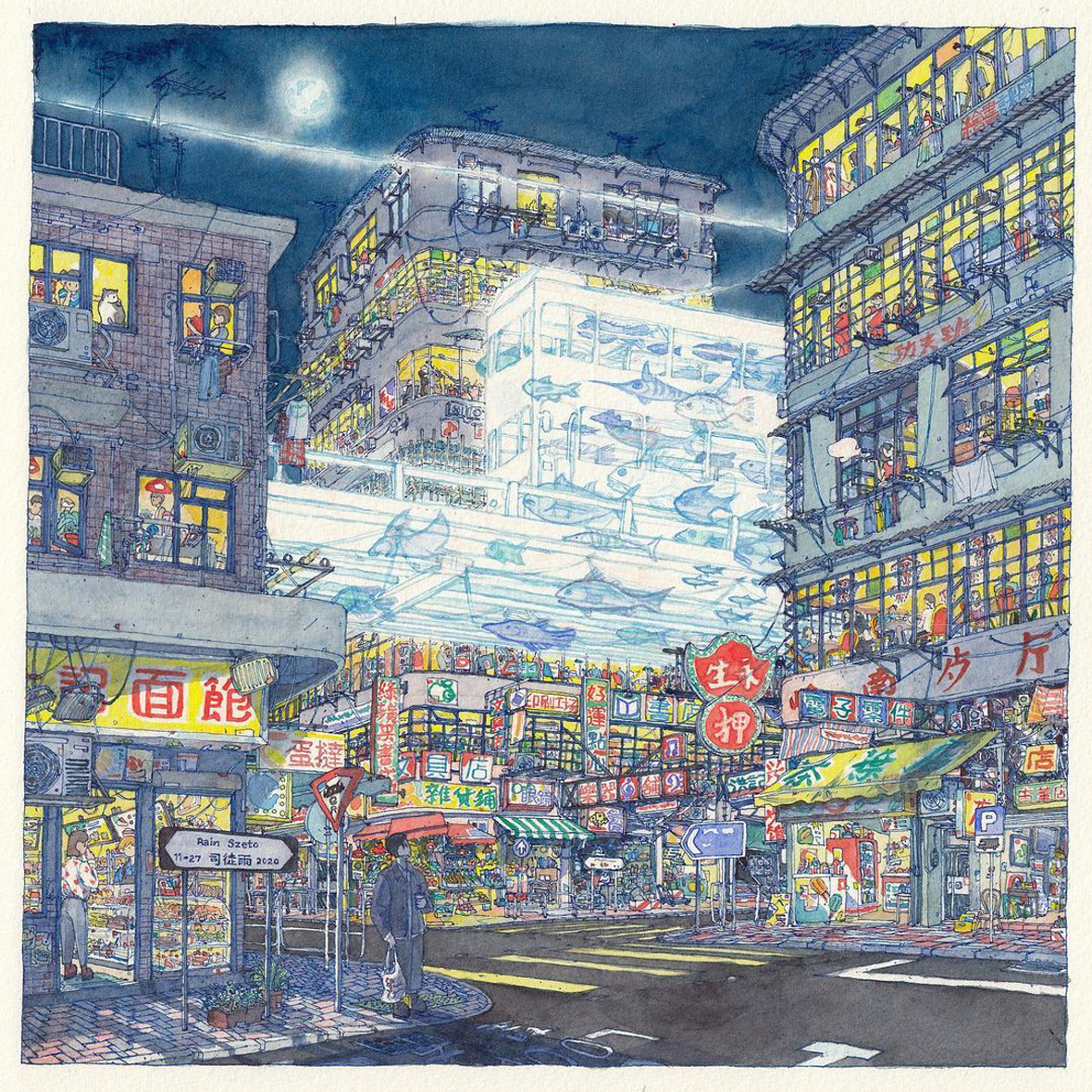
While studying art at a university in Chicago, Szeto was originally interested in comic art. But she soon realized that her favorite part of the medium was the establishing scenes—the large, detailed pictures situating a character in their environment. It’s a pretty clear line from there to her current style, which she landed on about two years ago. You can see the influence in her compositions as well, where scenes are usually contained within framing that resembles a comic panel.
She used to draw and paint everything manually until about a year ago when she realized using a miniature projector was an efficient way to transfer digital sketches to paper. But she only sketches her characters digitally, because she says she was getting lost in the infinite zoom on her tablet. “I was getting too stuck in details that wouldn’t be legible at the actual physical size. For example, I would spend time detailing a bolt, only to realize that it was reduced to a tiny dot once transferred to paper.” She also does rough color and shading studies digitally before adding paint to her final pieces.
Rain 此前在芝加哥一所大学攻读艺术专业,最初的兴趣是漫画。但很快她就意识到,自己更喜欢将场景融入创作,将角色置于充满大量细节的环境之中。她开始尝试转变创作思路,并在两年前开始逐渐形成现在的作品风格。从她作品构图中不难发现明显的日式漫画痕迹。
她早期的创作都以手绘制成,直到大约一年前,她尝试使用迷你投影仪,将数字草图的映像直接投影在画纸上,使得创作效率大大加分。数字创作的部分主要侧重人物,原因是平板电脑的无限变焦让她一不小心迷失在事物的细节。Rain 解释说:“我很容易会过分纠结于一些细节,而这些细节最终在实物作品中可能根本无法辨析。可能我会花很多时间来细致描画一个机械螺栓,最后却发现这些无足轻重的小部件在画纸上根本无法辨认。”此外,她还会在数字创作阶段进行粗略的上色测试,之后再给决定作品使用的颜色。
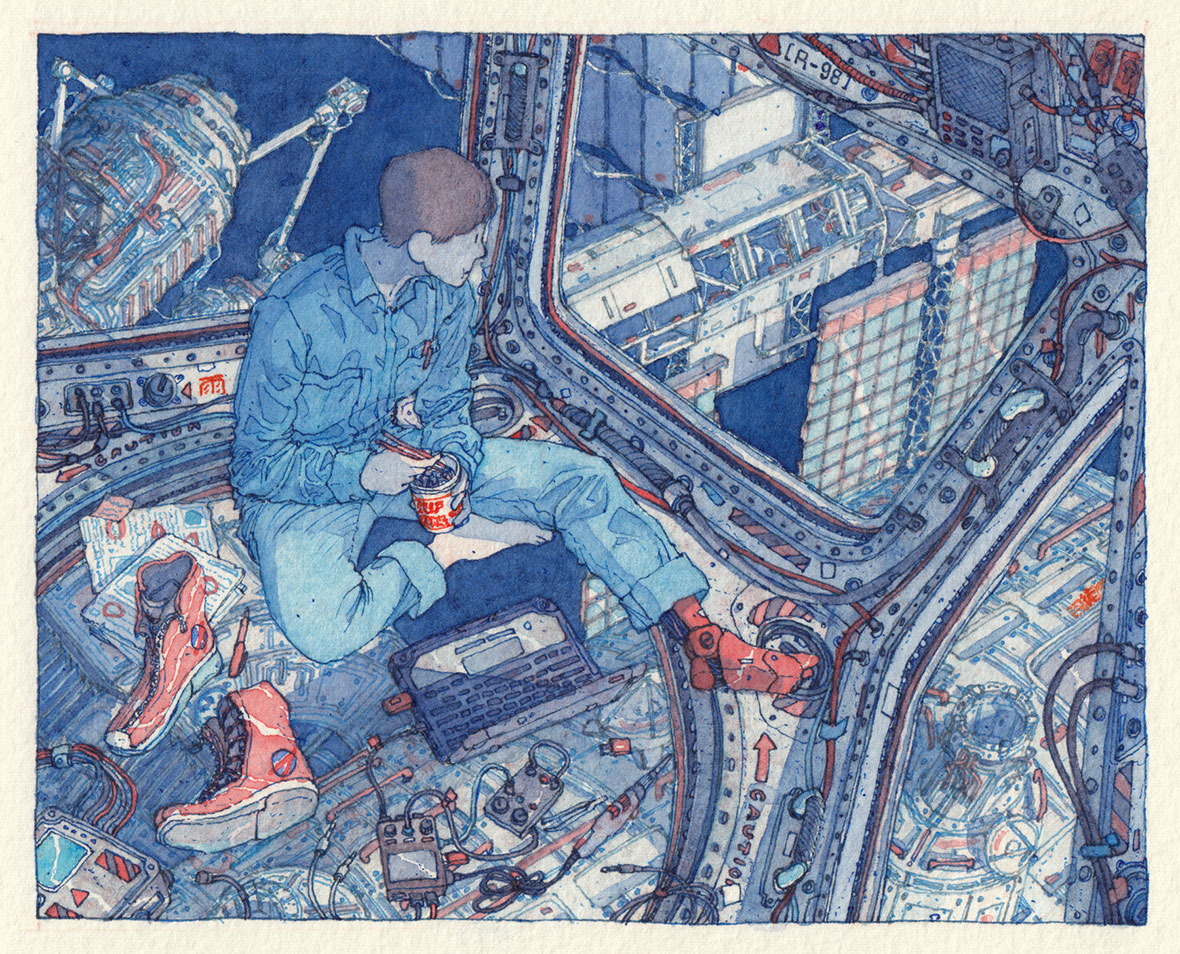
Szeto’s work is based on a combination of memories, photographs, and the internet. She combines multiple reference images for each piece, and she says they’re especially important for her sci-fi pieces in order to make the details believable. “I’m no engineer, so I have to search for real-world examples of how an engineer would arrange their workbench.” She compares her process to “kitbashing,” where model builders combine multiple kits to create something new and unique. “A lot of the machines in my sci-fi pieces are imaginary but reference parts from real-world machinery.”
The street scenes are usually based on places in Hong Kong or San Francisco but not usually as exact reproductions. (She was born and raised in San Francisco, and her parents are first-generation immigrants from Hong Kong and Nanping.) “When I’m out and about doing other things, such as grocery shopping, I’ll keep an eye out for interesting details, arrangements, etc. It’s more about keeping myself open to inspiration rather than seeking it out. I often find that if I go out specifically to find inspiration, it eludes me.”
Rain 的作品糅合了记忆、照片和网络素材。她的每幅作品都基于多张图片进行参考,这对于创作科幻题材的作品尤其重要,即在确保细节真实性下进行想象,“我不是工程师,因此参考现实里工作台细节是必要的。”她将自己的创作过程比作“Kitbashing”(实现快速概念设计),即建模者将多个原本的模型组合在一起,创造全新且独特的模型过程,“在我的科幻作品中,即便许多机器都是虚构的,但都参考了现实世界的机器零件。”
她从小在旧金山长大,父母是来自香港和南平的第一代移民。因此,她作品中的街景通常以香港或旧金山为原型,但不会原封不动地照搬。“每次出门上街,比如去杂货店买东西,我都会特别留意各种有趣的细节和布置,等待灵光一闪的时刻,但不会刻意去寻找灵感。一旦我刻意地去寻找灵感,往往都会无功而返。”
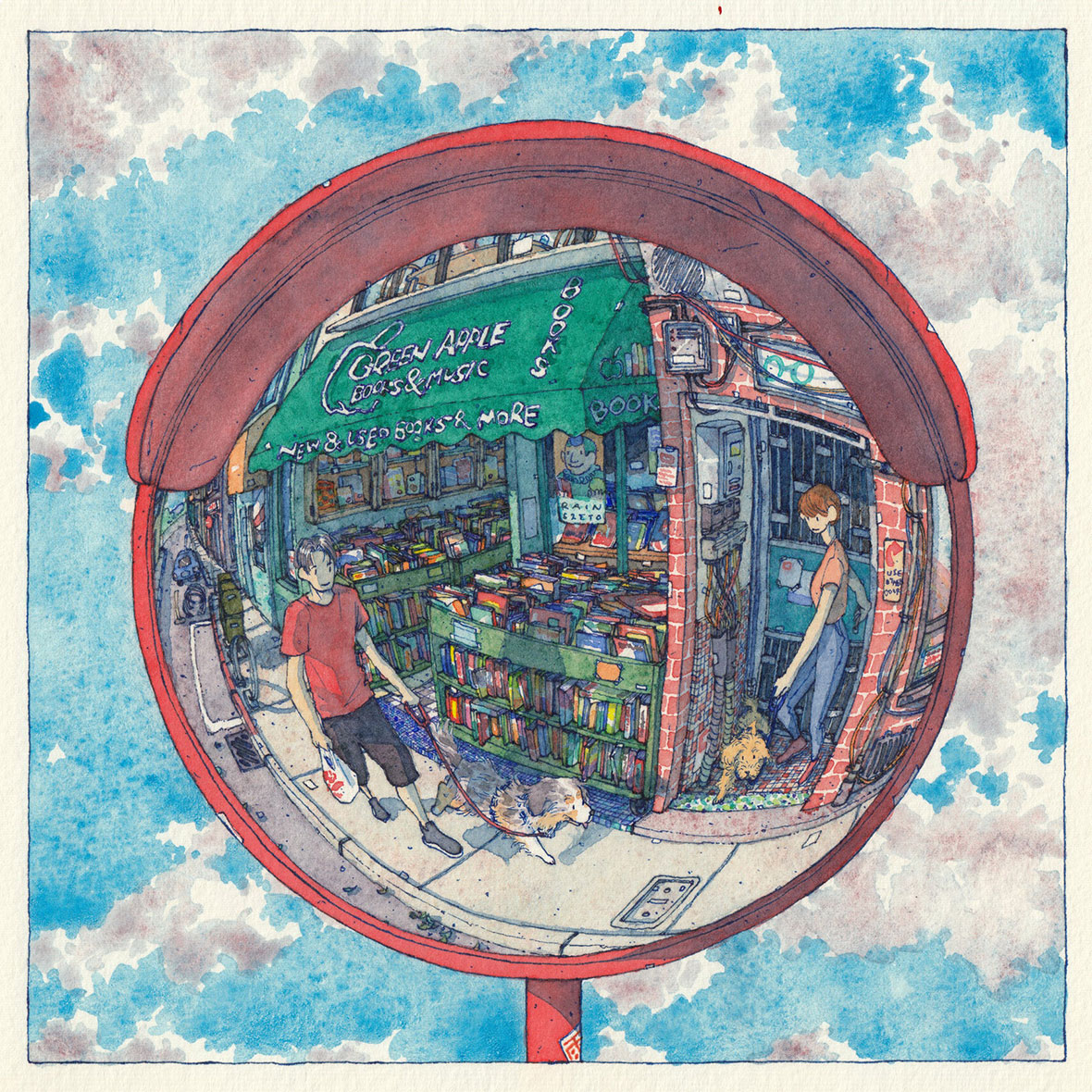
Sometimes the lines are blurred between real life and science-fiction. “Space Noodle” is actually based on a photo of the cupola module in the International Space Station, so it’s not exactly fiction, except for the artificial gravity and cyborg limb. Even in the cold vacuum of space, Szeto makes it feel like a quiet, everyday moment. The main character sits on the floor, leg crossed and sneakers off, snacking on some comfort food. “My mom came up with the title: When she first moved to America, she always called the Space Needle in Seattle the Space Noodle,” she laughs.
有时,现实和科幻之间的界限是模糊的。作品《Space Noodle(太空面条)》以国际空间站一张穹顶舱的照片为原型而创作的作品。除了人工重力和半机械人肢体之外,画中的其他元素并非虚构。而即使是冰冷的真空空间,Rain 也让整个画面透露出平静的日常气息。画中的主人公脱下运动鞋,双腿盘坐在地板上,正享受着手里的泡面,“作品标题是妈妈帮我起的。她刚搬到美国时,总是把西雅图的太空针塔(Space Needle)叫作太空面条(Space Noodle),”她笑着说道。
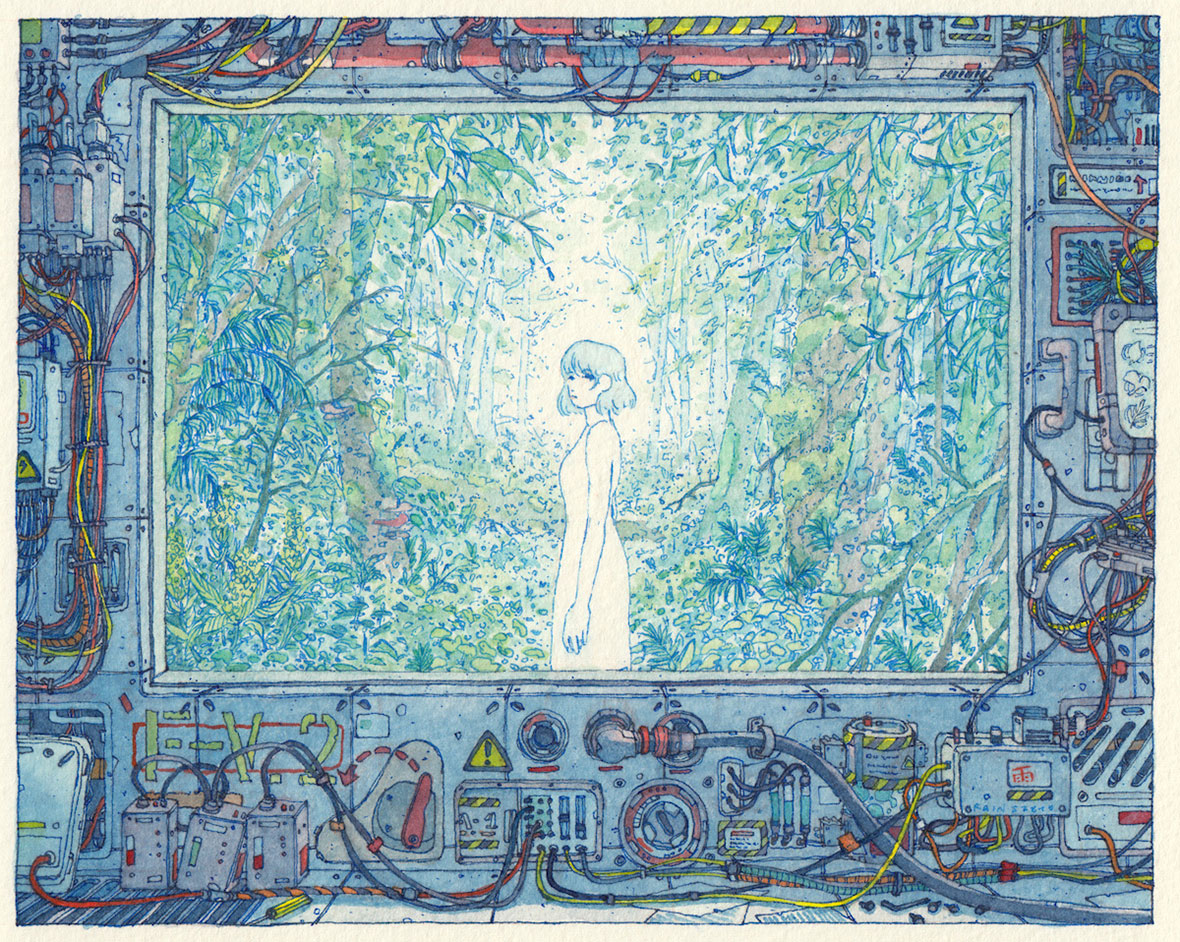
Szeto prefers to avoid darker themes, and likes the description of “gentle sci-fi” that a classmate once used for her work. An exception is “Forest 2.0,” which imagines a world where forests no longer exist and depicts a ghostly woman standing in lush foliage grown within a sophisticated electronic box. A messy array of levers, wires, pipes, and breakers keep the plants healthy but on life support. “It’s hard to ignore the influence of the climate crisis,” she says, explaining her reasons for broaching difficult subject matter. “But even though it depicts a post-natural world, it’s not quite apocalyptic or dystopian. It’s ambiguous whether the forest is meant to restore the natural world or is just a reminder of the past. I’d like to believe the former! It may seem cliché, but I’ll be glad if my art can make people happy.”
Rain 很少创作黑暗风格的主题,之前身边同学称她的创作是“温柔的科幻作品”,对此她表示十分赞同。不过,作品《Forest 2.0(森林2.0)》则不再温柔。其描绘了一个与现实隔绝的森林世界,一位白衣女子四下张望,森林之外,则是一个电路环绕的密闭空间,仿佛一切只是一场实验,像极了《银翼杀手2049》中安娜博士的实验室。
关于这幅作品,Rain 解释道:“气候危机的影响不容忽视。作品描绘的是一个自然消失后的世界。作品中,森林的意义,也许是被用来重建自然世界,或是为了提醒人们过去大自然的存在,其实作品中并没有明确说明。而我更愿意相信是前者!虽然这么说有点陈词滥调,但我觉得,如果我的作品能带给人们快乐,我也会很开心。”
Like our stories? Follow us on Facebook and Instagram.
Instagram: @rainfsh
Contributor: Mike Steyels
Chinese Translation: Olivia Li

